Three of the biggest stars of Broadway Palm’s “Annie” are making their theatrical debuts. Their names are Casey, Gritty and Teegan and they take turns playing the stray Annie rescues after she escapes from the orphanage.

Casey’s person is Anna Fink.
“Casey actually has an advanced trick title,” said Fink. “He does all kind of tricks, including walking backward up walls. He apparently does them mostly just for me and my husband now.”

Gritty’s mom is Andrea Mewhinney.
“Gritty has no training. She has no sit. No down. No wave. No read the dictionary,” said Mewhinney tongue-in-cheek. “But she stands and looks beautiful.”

Teegan’s person is Brenna Yuknis.
“Teegan was originally born to be a guide dog,” Yuknis divulged. “I was her puppy raiser. When she went off to school, they found a medical issue with her so they didn’t want to pursue her training. So I got her back. Her early training really prepared her for the role that she’s in now.”
Casey had a rough start.
“He was pretty terrified the first two times he was out there. He did not do the curtain call,” Fink revealed. “He was struggling to stay on the stage.”
Now, he’s so excited to be on stage that he pulls his mom into the car whenever it’s time to go to the theater.
Gritty is a retired show dog. But even she experienced some stage fright, although from an unexpected source.
“The only thing that has troubled her is the orchestra. She thinks those small people in the pit are scary, and the slippery stage. She is not a big fan of that,” Mewhinney noted. “Otherwise, nothing fazes her. She’s used to crowds and noise and applause and whatever.”
While all three dogs have been bitten by the stage bug, Teegan’s person is the one who’s most eager for her pet to return to the stage once “Annie” closes.
“I actually Googled agents for dogs,” Yuknis said sheepishly.
Continue reading to find out how each canine adjusted to their Annie, how they spend their time between acts and what they do in their spare time.
“Annie” is onstage at Broadway Palm through August 9th.

MORE INFORMATION:
Since “Annie” premiered in 1976, Sandy has been part of the show. For the musical’s national tour, two dogs, Addison and Georgie, were specifically trained to play Annie’s beloved canine after being rescued - one from an animal shelter in North Carolina and the other from a high kill shelter in Pennsylvania.
Neither Casey, Gritty nor Teegan received any special training to prepare them for the role of Sandy. That’s because their previous experience as show, therapy and trick dogs uniquely qualified them to appear on the Broadway Palm stage.
For example, Casey, a six-year-old Golden Retriever, is a certified therapy dog with an advanced tricks title. So all Anna Fink had to do to prepare him to portray Sandy was to make sure he would not be distracted by the 450 faces or so in the audience each night that are watching as he walks out on stage.
“I did that primarily by making sure that Casey knows what he’s supposed to do, where he’s supposed to go and who he’s supposed to do that with,” Fink said.
As a show dog, Gritty is accustomed to being in front of crowds. She is also used to being handled by strangers, especially judges, who typically examine each competitor’s teeth and run their hands over the dog’s paws, legs and bodies.
“Noise, crowds and me handing her to another person is normal for her,” said Andrea Mewhinney. “And she knows not to move an inch while a judge is examining her. But in terms of basic obedience, she knows nothing except to crawl up on the couch, watch Lifetime movies or Animal Planet, and look beautiful while doing it. That’s the sum total of what she knows.”
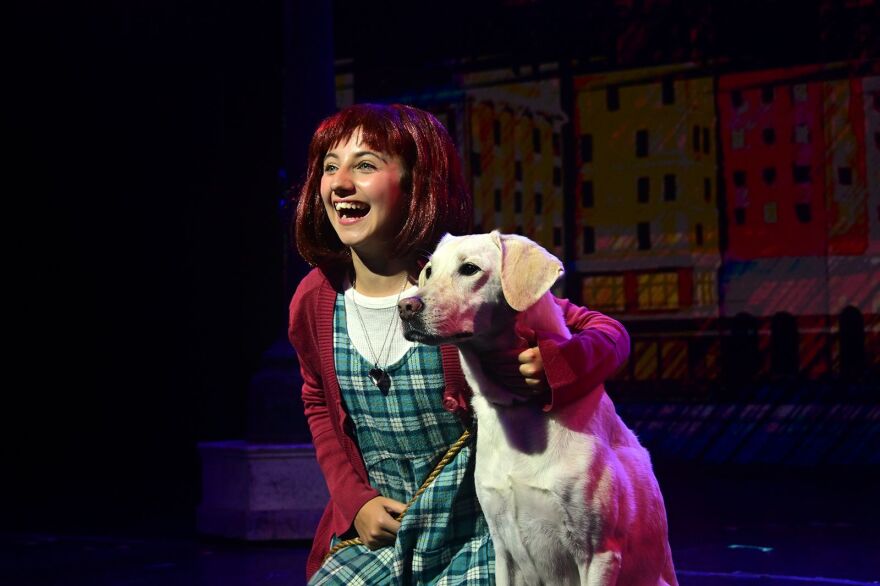
Teegan’s prep involved little more than brushing up on her obedience training. “Just her sit, stay and that kind of thing,” said Brenna Yuknis. “I also laid her down and pushed brooms and banged buckets near her. It turns out that she’s not in that scene, but it nonetheless taught her not to be distracted by noise or applause from doing the tasks she has to do in the show, like running across stage and going to Annie or the dog catcher.”
While performing in front of an orchestra and live audience was an adjustment, Casey, Gritty and Teegan were aided in this transition by their experiences in venues filled with strangers.
Certified therapy dogs are taken frequently to settings that range from nursing homes, assisted living facilities, rehab facilities and mental health institutions to airports, schools, college campuses, hospitals, cancer centers and hospice facilities.
“Casey and I are a certified therapy team,” Fink noted.
They received their certification from the Alliance for Therapy Dogs. ATD focuses on the well-being and the behavior of therapy dog candidates regardless of age or breed.
“We look for well-mannered, well-behaved dogs that enjoy meeting people,” the Alliance states on its website.
“There’s testing that has to be done [to become certified],” said Fink. “But mostly, you just have to have a dog that’s exposed to a lot of different things so they’re not scared of machines, people, people with hats, people with beards. If you pass the test, then you are placed with someone who can provide you with therapy opportunities. We’re with the Beesley’s Paw Prints out of the United Way. We work on their team mostly. We’re also credentialed for Gulf Coast Hospital. So we do lots of different things. We go to lots of different places, including fairs and the police demonstrations, and things like that.”
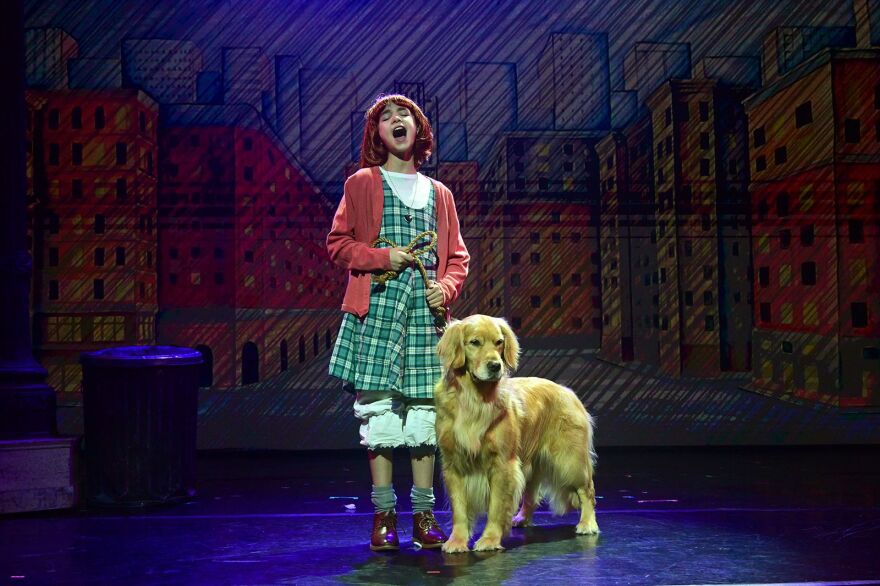
Gritty, too, is a certified therapy dog. Andrea Mewhinney explains how that came about.
“When Gritty retired as a show dog, I thought, ‘You need a job.’ So we took the test to get her certified. We went to Home Depot. We went to nursing homes. And an observer watched her with people. She loves everybody. She’s polite.”
Gritty’s only issue was walkers with tennis balls at the bottom of their stationary legs. She became obsessed with them.
“So now we go to Health Park and she visits people every week,” Mewhinney added. “I work there and she goes to my unit to visit. She likes it. Actually, she’ll go anywhere I ask her to go and what I find fun is her manners are always perfect. She’s always very well behaved. Very quiet. She never barks. She never makes a noise. And people like her. She’s a social butterfly. Good to have as my wingman.”
While acclimating to large audiences and loud applause may have been the dogs' biggest challenge, interacting with the actors who play Annie presented issues as well. In this instance, age and size figured prominently in the equation.
Broadway Palm cast two young actors who play the lead in Annie: Addie Jaymes and Sophe Nesanelis. Like Casey, Gritty and Teegan, both are making their Broadway Palm debut in the role.
Prior to joining the cast of “Annie,” Jaymes appeared elsewhere in “A Christmas Story,” “Annie Tour,” “Annie Warbucks,” “Gypsy” and “The Pianist.” Nesanelis was previously seen in the national tours of “Les Miserables” and “How the Grinch Stole Christmas the Musical,” as well as in “Wedding Band,” “Ragtime,” “Matilda the Musical” and “The Sound of Music.” She has also been seen in TV/film in “This Boys Vida” and “Blue’s Clues.”
Jaymes is older and bigger; Nesanelis, younger and more petit. Gritty, on the other hand, is big and strong; Casey and Teegan smaller but no less strong.
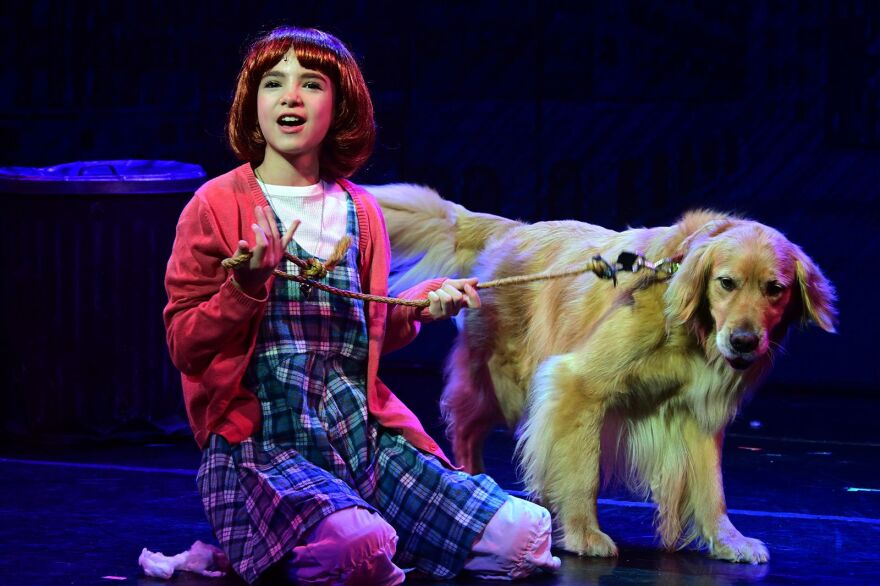
“Gritty was fine with Addie, who’s older,” Mewhinney acknowledged. “Sophe is younger and a little more petit and, as big as Gritty is, she dragged her around a little bit. Gritty can be a little intimidating when you’re nine years old, but Sophe seemed to outgrow that and had a wonderful time with her.”
As a consequence, Gritty works onstage primarily with Addie while both actors split time with Casey.
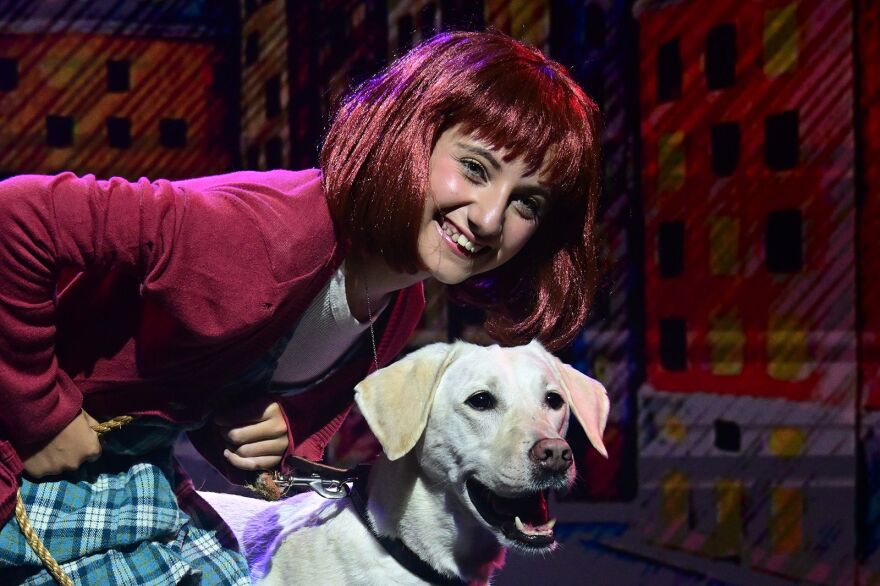
“Teegan works only with Sophe,” Yuknis noted. “Not only is she a little more petit, she’s never had a dog in her life before. So he and her are still building their relationship a little bit. She’s using treats to lure him and have him do what he needs to do. But, yeah, they’ve finally gotten a bond together.”
Now that they have more than a dozen shows under their collars, Casey, Gritty and Teegan are loving their time onstage.
“Teegan drags me in here every day,” said Yuknis. “She waits for the stage manager to come around the corner and lock eyes with her. Then she’s off to go backstage. She just loves it.”
“Casey is the same as Teegan,” said Fink. “He pulls me into the car and it’s like he’s saying, ‘Omigosh, are we going to the theater?’ The kids here are awesome. So are the adults. Everybody is so friendly and so really, really interested in making sure he’s comfortable. Every single person backstage makes sure they look out for him. They look out for all the actors, but particularly him.”
Each canine has to endure quite a bit of downtime whenever they’re scheduled to perform. They typically arrive 30 to 60 minutes before curtain and although the show runs two and one-half hours including intermission, Sandy is only onstage 14 minutes per show. In fact, there’s a long gap between Sandy’s last appearance in Act One and re-appearance in the final scene of the musical.
“Andrea was nice enough to bring a crate, so we can put Casey in the crate to get some down time and relax in between scenes,” said Fink. “It’s been really helpful. He typically goes into the crate right after the second act starts because he doesn’t actually appear again until the very last scene of the show. I sometimes take him out for a walk. We walk around, let him do his business, let him sniff a little bit, but otherwise that’s pretty much what he does, just go lay down.”
“Gritty goes in the crate, but she’s not a big fan of the crate since most of her life has been spent in a crate,” said Mewhinney. “I let her come out and we go hang out with the cast a little bit so that they can get golden fibers all over them. But at her age, you know, she’s middle aged now so she’s perfectly happy taking a nap and then just before her performances, I get her out. I make sure she’s empty and stretch her legs a little bit and Sean, the stage manager, comes and gets her.”
Teegan eschews the crate for the most part.
“So for her, I put a blanket down backstage on what we’ve come to call the canine couch,” Yuknis reported. “She sits next to me and the cast, as they’re passing by, because it’s like a thoroughfare by the couch, they’re always petting her for good luck and saying ‘We love you Tee.’ and kissing her.”
By the end of the show, each dog is usually pretty tired. Most sleep in the car on their way home.
Shows also represent quite a commitment on the part of each canine’s mom, who spend the entire show backstage with their charge. That means that they don’t get to see their pet perform live onstage.
“I actually got to see the last dress rehearsal,” Yuknis equivocated. “Nobody told me no, so I was in the audience and I got to see her in the show.”
Yuknis finally did arrange for her whole family to see Teegan in the show.
“We had a Teegan Takeover last Wednesday night. Forty people came and we all had tee shirts,” Yuknis laughed.
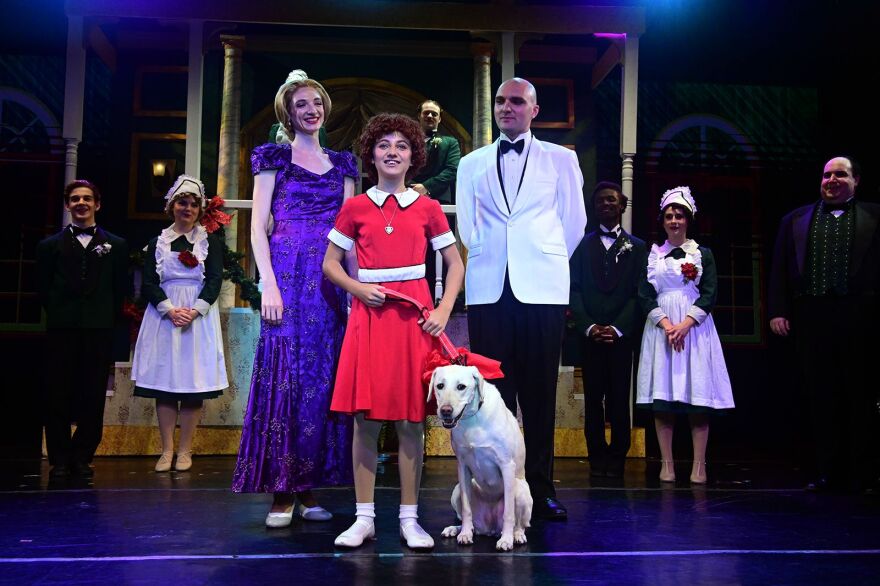
Fink has yet to see the show.
“I’m supposed to be here with my husband and family July 31st when he’s acting, but I kind of realize that’s probably not going to happen [because I’ll need to be backstage],” said Fink. “But we hear the entire production in the green room so you can track where they’re at and what’s going on. But I still haven’t actually seen him yet. I would love to do that sometime.”
Mewhinney saw the show on its opening weekend, although not with Gritty in the role of Sandy.
“I think Casey was on that night. It’s a wonderful production,” said Mewhinney. “The whole cast is so talented, and the orphans definitely are worth watching.”
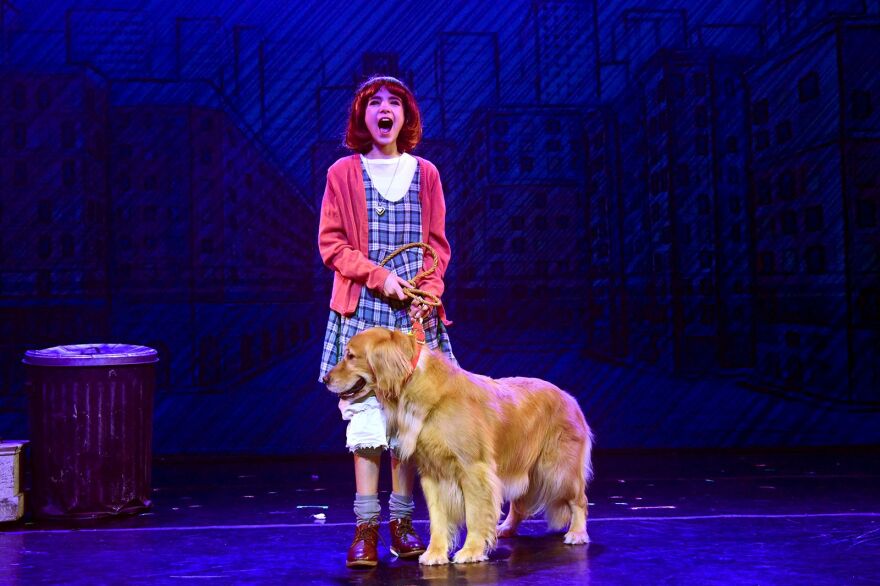
Yuknis echoed that sentiment.
“My parting words are this cast has been nothing but phenomenal. Everybody has been so welcoming and loving and accepting and like we’re one of them when we’re back there. And the production is amazing and everyone should come see it.”
In case you’re wondering, Casey earned his advanced trick title during COVID.
“We had a training facility in Maryland and during COVID, we didn’t have much to do so there were virtual training classes on Zoom with trainers that Casey had previously worked with,” Fink recounted. “So we just went through each one of the classes. He tested, and then got a certificate, and then we went on to the next level, tested and the same thing. So we did virtual classes every Saturday morning at home with the trainers. So that’s how he did it.”
Casey does all the usual tricks, like rolling over, playing dead and shaking paws. But his favorite trick is spinning.
“He likes spins a lot,” laughed Fink. “He spins forward and backwards. Everybody asks for roll over, and he does the wave, he does the paw and the high five as well. But again [laughing] mostly just for me and my husband.”
Although Teegan does not have an advanced tricks title, he knows how to wave and so she waves to the audience during bows at the end of “Annie” each time she’s onstage.
Support for WGCU’s arts & culture reporting comes from the Estate of Myra Janco Daniels, the Charles M. and Joan R. Taylor Foundation, and Naomi Bloom in loving memory of her husband, Ron Wallace.
WGCU is your trusted source for news and information in Southwest Florida. We are a nonprofit public service, and your support is more critical than ever. Keep public media strong and donate now. Thank you.
To read more stories about the arts in Southwest Florida visit Tom Hall's website: SWFL Art in the News.

